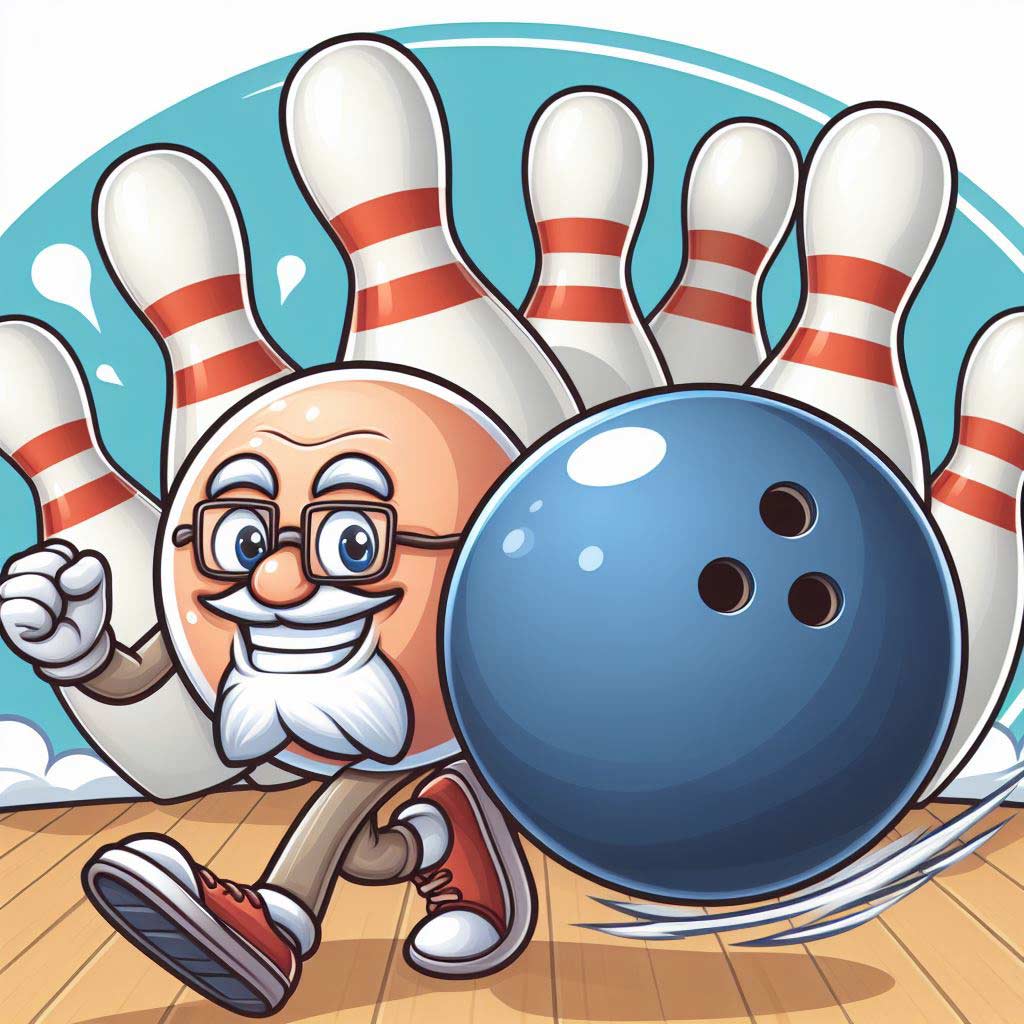Bowling is a classic sport that people of all ages can enjoy. For seniors in particular, bowling offers many benefits. It provides low-impact physical activity that is easy on joints and muscles.
Bowling also stimulates cognitive function as you constantly calculate shots and keep score. And of course, bowling is a social activity that allows seniors to get out of the house and engage with others.
While bowling does come easier to some people than others, it is a sport that anyone can learn with practice. With some adjustments and dedication to improving, seniors can enhance their bowling skills and become better players over time.
This article will provide 10 helpful bowling tips specifically for senior bowlers. Implementing just a few of these pointers can help seniors gain confidence on the lanes, improve their scores, and maximize their enjoyment of the sport.
Use a Lighter Ball
One of the best starting points for senior bowling is to use a ball with a weight you can comfortably handle. Heavier balls that are between 12 to 16 pounds are common for many adult players.
However, senior bowlers will often be better suited to lighter balls in the 6 to 10-pound range. There are a few reasons why using a lighter ball can be beneficial:
- Improved Control – With a lighter ball, seniors can more easily swing the ball, support the weight through the swing, and avoid straying off target at release. This allows better control over where the ball goes down the lane.
- Less Arm Strain – Bowling balls become heavy over the course of several frames. A lighter ball won’t fatigue the arm, shoulder, and back muscles as much.
- Better Balance – Heaving a heavy ball can throw off the body’s equilibrium if the muscles have weakened with age. Lighter balls help keep balance during the approach and release.
While ego may tempt some seniors to go heavier, swallowing pride and using a lighter ball that allows better functioning is wise. Don’t be afraid to try different weights to find the optimal one. The added control will be worth it and lead to higher scores.
Take Advantage of Ramps
For seniors who struggle moving or lifting even lighter balls, ramps provide excellent accommodation. Bowling ramps are devices that allow the player to gently roll or slide the ball down to gain momentum before it reaches the lane.
This eliminates the need to swing the ball with as much force. Ramps come in portable types or are installed on certain lanes. Ask the bowling alley ahead of time if ramps are available.
When using a ramp, the senior bowler can concentrate on these aspects:
- Proper ball positioning/placement at the top of the ramp
- Aiming the ramp to have the ball hit the targeted skid marks
- Steadying the ball as it travels down
- Developing the right speed/force
Ramps allow seniors with limited mobility to participate in the sport without overly straining themselves. Bowlers unable to lift a ball can use a push ramp to propel the ball with an assistive device or partner’s help. Ramps significantly open up senior bowling to those who could not otherwise play.
Use Two Hands
Two-handed bowling has surged in popularity in recent years. Power players like Jason Belmonte have showcased how the two-handed technique can create high revolutions and pin action.
While two hands may seem like an unorthodox style, it actually has some benefits specifically for senior bowlers. The main advantages are:
- Increased Stability – Holding the ball with two hands rather than one provides more overall control and balance during the swing and release. This can compensate for loss of stability with age.
- Better Accuracy – Guiding and supporting the ball with both hands generally allows seniors to aim more precisely and consistently hit their mark. Releases stray off target less frequently.
- Less Strain – Distributing load and effort across two hands/arms reduces strain compared to bowling with a one-handed approach. Two hands share the work during the swing motion.
Seniors who are wary of changing from lifelong one-handed bowling can try two hands just for spares or use both hands only on the initial push away before switching to one. But they may find that adopting a two-handed style full-time helps their game as they age.
Focus on Proper Form and Release
Having proper form is important for bowlers of all ages if they want to be accurate and minimize injury risk. But form becomes especially significant for seniors who likely need to compensate for decreased strength, flexibility, and balance. Three key areas for seniors to focus on are:
- Stance – Stand with the non-dominant foot slightly ahead of the dominant foot. Shoulder-width apart provides a good balance. Use adjustable wrist/knee supports if needed. Keep posture upright, not leaning over.
- Arm Swing – Draw the ball straight back keeping the elbow close to the body. Let gravity pull the ball down in the pendulum swing. Minimize muscle effort. Follow through straight toward the target.
- Release – Allow the thumb to exit the ball first with a slight upward turn of the wrist. Avoid squeezing fingers at release. Allow momentum to guide the ball out of the hand.
Investing time to develop proper form will help seniors have mastery over their swing and release. Being able to repeat a controlled, accurate motion is key. Seek coaching or watch videos to correct any poor habits.
Consider Wrist Braces
Bowling puts strain on the wrist, especially at release when the bowling ball weighs down on the wrist joint. For seniors, wrist pain and susceptibility to injury may increase due to arthritis or prior orthopedic issues. Supporting the joint with a brace can allow older bowlers to continue participating in the sport comfortably.
Wrist braces tailor-made for bowling provide these benefits:
- Compress and support the joint during motions
- Keep the wrist properly aligned at release
- Protect from hyperextension or impact injuries
- Reduce pain from arthritis or tendonitis
The flexible, breathable fabric allows free motion while giving stability. Braces slide onto the thumb or wrist area. They provide compression without impeding swing or grip. Consult a doctor to find the right brace for your needs. With the proper support, seniors can bowl without aggravating wrist problems.
Try Bowling Shoes
Bowling shoes may seem like an unnecessary expense if seniors are used to bowling in their everyday athletic shoes. However, using shoes designed for bowling can give an advantage. Bowling shoes have special soles to help with slide and traction. Here’s how:
- The sole under the sliding foot is leather or microfiber to glide smoothly across the lane.
- The other sole has more grip to provide force during the second step.
- The heels are low and flat to minimize strain on the legs and back.
The shoes allow seniors to perform that effortless slide-step approach more safely. The sliding motion becomes smoother and more controlled. Traction, where needed, prevents slipping. Look for lightweight bowling shoes that provide ankle support and stability for seniors as well. Proper footwear makes a difference in comfort and bowling abilities.
Strengthen with Exercise
Building muscle strength and balance through exercise helps compensate for age-related physical decline. Stronger legs, core, and arms allow seniors to bowl with better power, control, and stamina. Any exercise that strengthens the muscles used in bowling is beneficial. Great options include:
- Cardio – Brisk walking, swimming, dancing. Improves stamina.
- Strength Training – Lifting free weights for arms and core muscles.
- Yoga – For balance, flexibility, core and arm strength.
- Stretches – Shoulder, wrist, knee, and back stretches.
- Balance Exercises – Tai chi, backward walking, balancing on one foot.
Consult a physical therapist or coach on appropriate exercises. The right cross-training regimen can keep seniors rolling strike after strike as their strength improves. Even light training can make a difference.
Practice Regularly
Consistent practice is the key to honing bowling skills no matter your age or ability. Frequent bowling keeps muscle memory sharp, and skills don’t decline as rapidly. Seniors should try to practice at least once a week if not more. Mini practice sessions on home bowling lane kits can also help.
When practicing, don’t just play full games. Really focus on weak spots like:
- Spare shooting accuracy
- Adjusting angles and location across the lane
- Achieving proper speed and revs
- Hitting the pocket consistently
Track progress in a notebook. Video record your swing to check the form. Seniors will see their scores steadily increase with attentive, purposeful practice. Be patient and keep trying to improve.
Relax and Have Fun!
While it’s enjoyable to improve your bowling abilities, don’t put too much pressure on yourself about scores as a senior. Focus on the social, fun aspects of bowling with friends and family. Being tense or frustrated can negatively impact performance and enjoyment. Keep these pointers in mind:
- Don’t worry about gutter balls or low scores. Laugh them off!
- Converse and joke around with others when waiting your turn.
- Applaud and encourage other players on nice shots.
- Sit and rest between turns if needed. Stay hydrated.
- Vary games and switch teams if playing in groups.
Bowling better comes naturally the more you relax and have fun with it! The activity should reduce senior stress, not cause it. Keep the experience light-hearted.
Consider Lessons
If looking to improve quickly, private or group bowling lessons can benefit senior players immensely. An experienced coach observes your mechanics and provides specialized advice. Lessons help ingrain proper techniques so seniors can reach the next level.
A coach can identify issues like:
- An inefficient approach
- Grip issues causing a lack of control
- Poor timing of the swing
- Incorrect positioning of the ball at release
Personalized instruction speeds up skill development. Coaches demonstrate proper form and give useful drills. Look for a coach experienced with senior players. Just a few lessons build confidence and improve technique.
Conclusion
Bowling is an adaptable sport with benefits for senior participants such as social connection, cognitive stimulation, and low-impact activity. Seniors should not feel intimidated about getting involved with bowling or improving their skills.
Implementing these practical bowling tips will help older adults enjoy the sport to the fullest and achieve greater success on the lanes.
The right ball weight, adaptive equipment, appropriate shoes, targeted exercises, and regular practice all contribute to better bowling.
Most importantly, maintaining a fun, supportive atmosphere will keep seniors enthusiastic about hitting the alley. Bowling can deliver immense physical and mental rewards for players in their golden years.
Frequently Asked Questions
What weight bowling ball should a 70 year old man use?
A 70-year-old man should generally use a bowling ball between 10-12 lbs. Anything under 12 lbs allows better control and reduces fatigue or strain for older bowlers. The ball should be still heavy enough to have momentum and carry power. Senior men who are active and have stronger builds could potentially go up to 14 lbs. But a lighter 10-12 lb range is a good starting point.
How do you throw better in bowling?
To improve bowling accuracy and scores, focus on a proper approach, steady arm swing, and clean release. Keep your arm relaxed during the backswing and downswing. At release, let gravity pull the ball off your fingertips with a slight upward wrist turn. Follow through straight toward the target. Aim for the pocket between the 1-3 pins or arrow marker. Practice makes your technique more repeatable.
How can I improve my bowling for beginners?
Beginner bowlers should get fitted for the right ball weight, learn proper hand placement in the ball, and practice the footwork of the approach. Invest in your own ball and shoes. Master straight bowling before learning hooks – aim for the arrows at the foul line. Work on spares by moving laterally across the lane to adjust your angle. Take lessons and watch educational videos. Bowl regularly to hone muscle memory.
What is the best bowling technique?
The optimal bowling technique involves a four or five-step approach, a pendulum arm swing straight back and down, a slight bend in the slide knee, a straight ball release off the fingertips, and a straight followthrough toward your target. Power comes from your legs and core, not muscling the ball. Stay relaxed and balanced. The proper form allows you to be accurate and consistent.
How do I know if my bowling ball is too heavy?
Signs your bowling ball may be too heavy include straining to swing it, the need to muscle it with shoulders vs letting it pendulum swing, reduced control, fatigue toward the end of games, and discomfort or pain in the fingers, wrist, or shoulder. You want a ball that feels comfortably challenging but doesn’t wear you out or sacrifice technique.
Is it better to bowl with a heavier ball?
Heavier balls around 14-16 lbs can provide more power and pin action for experienced adult bowlers. However using too heavy a ball negatively impacts control, balance, stamina, and proper form. Beginners, seniors, women, and youth are generally better suited to lighter balls they can handle well (10-12 lbs). Choose weight based on your strength and skill level.
Where do you aim when bowling a straight ball?
For straight bowling without a hook, pick an arrow marker just past the foul line. Your target is between the headpin and that arrow to achieve a pocket hit. If you stand on the left, aim between the 1-2 arrows. Standing right, aim between the 1-3 arrows. Adjust left or right as needed based on where your ball is impacting the pins.
How do I make my bowling ball more aggressive?
To increase bowling ball aggression, some options are switching to a reactive resin ball, changing to a fingertip grip from conventional, increasing speed/revs, using a cleaner/degreaser on the ball surface, adjusting hand and wrist position to impart more spin, and learning a hook release rather than straight bowling. Higher revs and spin translate to greater pin action.





